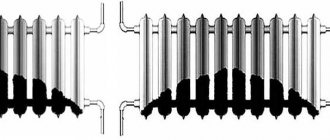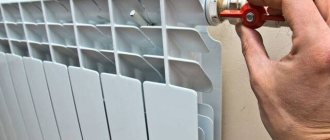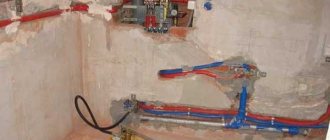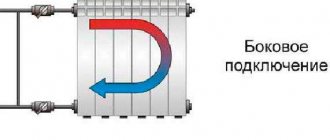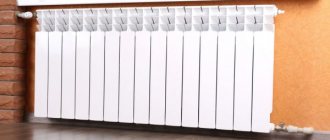Crimping
When performing work, the technician must remember that flushing and pressure testing of the heating system must be carried out together. The flushing process is necessary to restore the functionality of pipes and radiators; it has many options using various mechanisms and devices.
Pressure testing of the system is the process of checking its performance before starting the heating and preparing the batteries for load. The main task of the work is to test the tightness.
Pressure testing is carried out after each disassembly of the system for repair, replacement of parts or after installation.
The procedure consists of several steps:
- Air or water is supplied to the system using a pneumatic or hydraulic pump.
- By observing the behavior of the system, locations of leaks are identified.
When performing crimping, all faulty or incorrectly mounted parts will make themselves felt, and “healthy” elements will not be affected.
In modern heating systems, a complex of work to identify leaky areas can be carried out without the help of a large number of people. The master will only need special equipment to carry out the work.
Before starting work, it is necessary to identify the parameters that influence the crimping technology:
- Material and wall thickness.
- Number of floors in the building.
- Wiring type.
- Characteristics of fittings.
Crimping is carried out under different pressures, it depends on the pipe material and operating pressure. In private homes this figure is 2 atmospheres. When testing for leaks, the pressure is doubled relative to the working pressure. The work must be carried out by professional crimpers, because this is a complex process that requires training and certification of the team performing all the work.
Briefly about the main thing
To maintain the efficiency of heating quality, a number of rules must be followed:
- Avoid using unprepared liquid as a coolant. In its simplest form, preparation involves boiling. This way the amount of salts is significantly reduced. But it is more effective to purchase specially created inhibitors that reduce the activity of corrosive processes. When choosing them, you need to make sure that the composition and material of the surfaces match.
- Know when heating systems are flushed and strictly follow the main steps.
- Coarse filters must be installed on heating lines. They are mounted in such a way that the pipe faces down. This will make it easier to clean, since all dirt is drained simultaneously with water.
- When choosing a contractor company, pay attention to companies that provide a guarantee for the activities carried out.
The heating system is cleaned by the company's professional staff within one day. Therefore, you should not neglect this service. The result will be a constant comfortable temperature in all rooms, as well as significant savings on heating.
Ratings 0
Why is flushing the heating system in an apartment building so important?
Sometimes, deposits of salts, scale, rust and sand form inside the pipes and radiators of the central heating system of multi-storey buildings. This formation affects the material from which the heating system is made, and makes the flow pressure in the pipes much less. And this can lead to a system breakdown at the most inopportune moment.
And this threatens to flood the apartment with hot water, but this is not so important, but what is important is that this water can leak to the neighbors below and there is no way around this without compensation or repairs
Apart from such a catastrophe, clogged pipes and radiators entail many negative consequences.
The negative consequences of clogged radiators and heating system tinder are:
- When layers of dirt form in the pipe, the strength of the mechanical type of the heating system decreases.
- The friction of water on the inner walls of the pipes and radiator clearly increases, and this significantly reduces the speed of fluid flow.
- The thickness of the walls increases and this reduces the internal diameter of the pipe, and this reduces the heat transfer from the pipes and radiator. The temperature of the liquid also decreases, as it is subjected to thermal resistance.
- The formation of scale in the system increases the need for fuel for heating, which means an increase in utility costs.
To clean the internal surface of the system from deposits, it is necessary to carry out preventive work. Prevention can be carried out in different ways.
Prevention can be done in the following ways:
- The first method that can help is to try to improve the heat carrier; this can only be done in autonomous heating systems, but not in central heating systems;
- The second method is to flush and press the heating system, and this must be done regularly.
Preventative maintenance of pipes and radiators of the heating system is available to everyone, unlike improving the quality of the coolant.
When the need for flushing arises
Cleaning the heating system will be necessary if you notice the following signs in the heating operation:
- a drop in temperature in the home with stable operation of the boiler;
- pipes heat up too slowly;
- heating elements heat up unevenly;
- the pipelines are hot and the radiators are cold;
- fistulas often begin to appear in the pipes, and sometimes ruptures occur.
The manifestation of at least one of these signs may indicate that the heating system is clogged.
Chemical wash
There are only two cases in which this washing method can be used.
- If it is necessary to remove blockages in a natural circulation system that uses steel pipes. This is advisable when, for one reason or another, you do not want to completely change the system. The predominant part of the blockage is formed in the heat exchangers, if we are talking about deposits. Siltation occurs along the entire perimeter of the system, settling more at the bottom.
- If you need to resuscitate a heating system that has been operating for decades. The pipes gradually become overgrown and silted, resulting in reduced heating efficiency.
Video
Important information! If the pipes are old and not galvanized, then you will hardly notice the result of washing. The chemicals will dissolve the rust and new leaks will appear after the procedure.
In fact, the flushing procedure is extremely simple: instead of water, a special chemical composition is poured into the system, which includes alkali and acid. Next, the composition continuously circulates in the system for a couple of hours, then it is drained and plain water is refilled.
Such a chemical is not cheap - about 6,000 rubles for a twenty-five-liter canister. According to SNiP, this solution cannot be poured down the drain after use. At the same time, there are special neutralizing compounds on sale in case there is nowhere to put the used solution.
Important information! This solution must NOT be used for aluminum pipes, since the latter will last significantly less after washing!
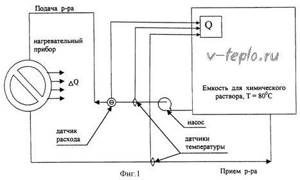
Top 10 best chemicals for flushing the heating system
Modern manufacturers offer consumers a wide selection of preparations for cleaning heating systems. It is necessary to choose a product taking into account the material of pipes and radiators.
The type of coolant - water or antifreeze - also matters. Systems filled with antifreeze are characterized by the deposition of sludge and glycol residues formed during the decomposition of the coolant. Other substances are used to dissolve them.
Ideally, before flushing the circuit, it is recommended to analyze the composition of the coolant and, depending on the substances contained in the circulating medium, select a product. But at home, no one will burden themselves with unnecessary complications.
Therefore, the masters use a product that I trust more. You must first study the manufacturer's recommendations on the packaging. According to consumer reviews, the following brands demonstrate the greatest efficiency.
How and how to flush radiators and heating systems
The process of cleaning the heating system of a house is not complicated; any owner can handle it.
There are several ways to clean the heating network in a private home with your own hands.
:
- mechanical flushing;
- dry cleaning;
- hydropneumatic flushing;
- pneumohydraulic hammer method;
- biological washing.
Mechanical flushing
This method of flushing heating systems requires complete disassembly of all communications - before cleaning the elements, you will have to remove every part of the system. The complexity of the method lies in cleaning the internal surfaces of pipes and batteries from scale and rust manually using metal brushes. Nowadays, it is practically not used, as it requires a significant investment of time and effort.
Chemical washing method
To clean the system, you need to connect a pump with a container filled with chemicals. The detergent dissolves and loosens contaminants stuck to the pipe walls.
For chemical cleaning, two types of liquids are used - acid or alkaline based, used depending on the material from which the pipes and batteries are made, as well as the type of deposits. It is recommended to flush the heating system with chemicals also in cases where it is too difficult to remove the system elements.
Alkali- or acid-based cleaning fluid cannot be used when working with aluminum batteries due to the fact that the metal reacts with chemical compounds. It is also prohibited to clean depressurized systems, since the chemical cleaning agent is toxic and can cause harm to health.
. For the same reason, used liquids should not be poured down the drain, and work should be performed with rubber gloves and a respirator.

After chemical cleaning, all contaminants will be completely removed, extending the life of the system.
Hydropneumatic flushing
This method involves treating the internal surfaces of batteries and pipes with a flow of a mixture of air and water supplied under high pressure. Flushing the heating system in this way is highly effective, but its use requires special equipment.
Hydropneumatic cleaning has proven itself excellent when working with cast iron radiators of the old type, still made in the Soviet Union. Cleaning with water and air does not impose any strict requirements on the elements of the heating system, like a chemical method, that is, it is equally suitable for all types of materials and pipes. Despite the high cost compared to the chemical method, it is completely safe and more effective.
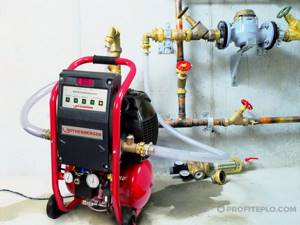
Equipment connected to the elevator for hydropneumatic washing
Before cleaning, it is recommended to treat batteries using a special composition that softens the crust of contaminants.
Pneumohydraulic hammer method
This method is the fastest (takes no more than an hour), convenient, since you do not have to dismantle the elements of the system, but requires the use of special equipment.
At the end of the heating communications, special equipment is attached - a pneumatic gun, with the help of which a pneumohydraulic pulse is supplied to the pipeline, peeling off pollutants adhering to the walls of pipes and batteries.
Despite the serious and frighteningly complex name, flushing pipes in this way is absolutely safe, since a force of no more than 2% of the pulse power is applied to the walls, and the main impact falls on the dirt.

Operating principle of pneumatic hydraulic shock
Biological washing
At its core, this method is very similar to the chemical one, only instead of dangerous reagents, high-tech solvents and proppant biological products are used. Under their influence, the crystalline bonds of pollutants are destroyed and corrosive and organic deposits are cleaned off.
The flushing biomaterial is produced on a water basis, and their use allows you to completely clean the heating network in an apartment building and in an individual home.
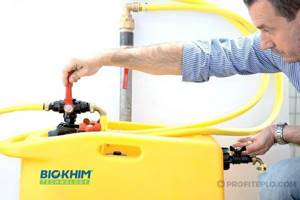
The process of cleaning pipes with flushing biomaterial
Conclusions and useful video on the topic
Video #1. The effectiveness of using hydropneumatic radiator flushing can be assessed by the amount of dirt thrown out:
Video #2. The subtleties of performing a chemical type of flushing of the heating system are outlined in the following story provided by the owner of a private household:
Any of the considered options for flushing heating systems does not represent an overly complicated procedure. If you have some experience in plumbing work and, in some cases, special equipment that can be rented, you can perform this operation yourself.
Would you like to talk about the effectiveness of flushing or tell us how you flushed the heating circuit in your home? Do you have valuable recommendations or important nuances that you would like to share with site visitors? Please write comments in the block form below.
Radiator cleaning
Let's imagine what the cleaning procedure will look like under different conditions.
Washing with a special device
To quickly and effectively clean radiators “without leaving the cash register,” there are special devices for washing them. Of course, having such a device for infrequent cleaning of a home battery is essentially a luxury.
The device operates from the mains - it drives water into the radiator with a powerful jet, which with its pressure removes scale, rust, grease, and various chemical deposits. But if you don’t have this device, you can replace it by cleaning the radiator in the bathtub.
Washing algorithm in the bath
How to wash batteries in an apartment without being able to take them outside? The instructions will consist of the following blocks:
- Filling with hot water. You will need to use a hose, shower, watering can, kettle with a narrow spout, or a regular funnel to pour hot water inside the radiator. Open both plugs to allow dirty water to flow out freely. Once there is enough liquid in the battery, shake it and pour out all the contents. The action should be repeated until large pieces of dirt fly out of the radiator being cleaned. It is worth noting that the procedure is difficult to perform alone - the weight of the battery is significant even for a brave athlete. Therefore, 1-2 assistants in this matter are vital for you.
Pouring cleaning agent. The second step is to pour the cleaning agent you have already chosen into the radiator, diluting it with water
Now it is important to put plugs on all the holes in the battery so that the “useful liquid” does not leak out of it. Depending on the drug, it is left to “acidify” for a period of 2 hours. As soon as the active component has expired, you need to shake the radiator again. You can knock on its various parts with a wooden, plastic, or rubber hammer
This will help further remove rust and other contaminants from its internal parts.
You can knock on its various parts with a wooden, plastic, or rubber hammer. This will help further remove rust and other contaminants from its internal parts.
Now it is important to thoroughly rinse the cleaning agent. Therefore, it is necessary to clean until the foam stops coming out, the smell stops being felt, or the other characteristic features of its presence are manifested in some other way. If you do not rinse the radiator completely, the active components of the product will continue to act, destroying the metal from the inside, which will cause leakage and failure of the battery.
If you do not rinse the radiator completely, the active components of the product will continue to act, destroying the metal from the inside, which will cause leakage and failure of the battery.
The videos in this article will show you how to clearly follow the instructions.
Features of cleaning in a private home
Cleaning batteries in your homes is even more important than in apartments. This is due to a number of heating features:
- The coolant is water from a well, borehole, or even a reservoir. Hence, there is more coarse dirt stuck in the radiator than in the water circulating through the lines of city heating systems. Therefore, the need for cleaning arises much more often.
- Not only the radiator is washed (blown), but also the heating main. After all, all the debris stuck in it will invariably end up in the cleaned battery.
- In case of urgent need, you can clean the radiator during the heating season. Otherwise, during the cold season, it makes no sense to turn off the heating system for cleaning.
Features of flushing during the heating season
If you decide to clean the battery during the cold season, then pay attention to the following:
- The cleaning method and detergents are the same.
- It is possible to flush radiators (in a private house) without removing them and without draining the water from the heating boiler:
- Disconnect the steam line completely while cleaning.
- Perform a purge.
- Put all the valves back on, and then run water through the thermal circuit.
- Feed it until absolutely clean water flows out of the pipeline.
The measures taken will clean not only the radiator, but also the entire heating line in general.
Thus, cleaning the radiator without removing it is only possible in your own home. Residents of apartments will have to remove it to clean the battery from the inside. An exception is for those who have a special device for cleaning batteries.
What causes pollution?
The main source of clogging that slows down the operation of heating units is the coolant. In the role of which tap water is used. When filling pipelines, small grains of sand and deposits enter with water and eventually settle on the walls of the radiators.
The second reason is scale. It occurs in the heat exchanger through contact of water with the hot walls of the boiler. Over time, the resulting layer covers the inner surface of the heating equipment, which subsequently negatively affects the output of thermal energy. If you do not periodically flush the system, scale can clog the channels of pipelines and radiators. Such consequences will lead to serious repairs and large financial costs.
Another main reason for low efficiency is the formation of rust on the walls of metal pipes. This occurs due to the high content of oxygen and salts in the water.
Options for flushing heating systems
The choice of cleaning method depends on the total length of the circuits, the degree of contamination and other factors. Methods include:
- Mechanical method.
- Hydrochemical cleaning.
- Hydrodynamic flushing.
- Electrohydropulse method.
- Hydropneumatic option.
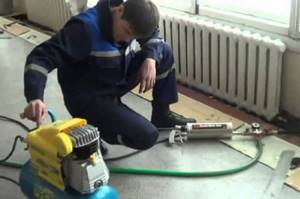
Some methods require equipment. Hydropneumatic guns can be rented, but you will need some skill to operate them.
There are a number of general rules for flushing the heating system of a private or apartment building. If you deviate from their implementation, efficiency will be low.
Mechanical cleaning
The method is suitable for cleaning batteries. All other elements will have to be cleaned separately. First you need to drain the coolant from the system. You must first close all valves that limit the flow of coolant into the radiator. In high-rise buildings, valves are usually located in the basement, in private houses - on parts of the circuit before and after the heating element.
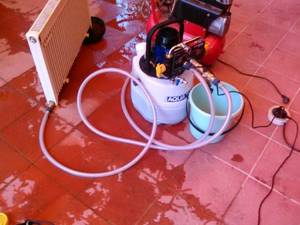
Mechanical cleaning
To drain the liquid, you need to open the drain valve located on the circuit. If it is missing, it is enough to unscrew the plugs on the last battery located below the others.
It is convenient to discharge the coolant through a hose that is connected to the tap and discharged into the sewer. The mechanical cleaning method is effective when the heating elements are first removed and the pipes and radiators are cleaned separately.
The dismantling method depends on the connection options and other parameters. It is necessary to protect the floor from flooding by placing a container. Take the radiator outside or into the bathroom (the enamel parts must be protected with a rag). To prevent clogging of the sewer, it is necessary to block the drain in the sink with a network.
After mechanical cleaning, it is necessary to rinse the pipes with plain water. Through a water tap or hose, supply water under pressure into the radiator. Rinsing is carried out until the water becomes clear.
Hydrodynamic cleaning
The method involves supplying water to the circuit from a pump under high pressure. Can be connected to an open circuit to use as many radiators as possible before the water is discharged. However, special hoses are used for this.
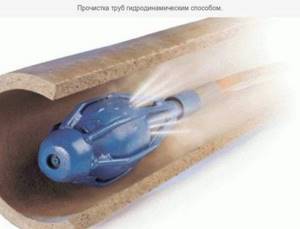
Hydrodynamic flushing principle
For small deposits, pressurized water effectively counteracts salts and dirt. You will have to rinse several times. After cleaning, the operation of the heating system will improve significantly.
Chemical washing method
The principle of the method is based on the introduction into the cavity of the radiator of substances that dissolve or promote the peeling of scale. They use both ready-made substances and solutions prepared with their own hands. It may not be necessary to remove radiators from brackets.
However, it is prohibited to wash aluminum radiators. Caustic solutions are formed that cannot be poured down the drain.
To clean lightly dirty circuits, it is enough to:
- Soda;
- Vinegar;
- Acid.
It is better to use special compounds. After finishing work with chemicals, it is necessary to flush the pipes.
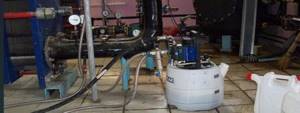
Dry cleaning
Hydropneumatic flushing
This cleaning method involves treating internal surfaces with an emulsion under high pressure. Emulsion is a mixture of water and oxygen. The effectiveness of the method is high, however, sophisticated equipment is required.
Suitable for cast iron radiators with large collector capacity. There are no strict requirements for the type or material of elements. The method is quite expensive, but is compensated by its effectiveness and safety. To reduce the impact on batteries, pre-treatment with chemicals is necessary.

Hydropneumatic
Electrohydropulse technique
The principle of operation of the method is to use an electrical pulse that destroys insoluble substances that transmit current.
To create an impulse of this level you need a special apparatus. A coaxial cord is connected to it, on which a charge is formed; the shock wave destroys scale on the surface of pipes or radiators. After cleaning, you need to rinse the system with clean water.

Electrohydropulse washing, results
This method is effective and does not require complete disassembly of the system. However, equipment is required. Slag waste can be washed down the drain.
Which parts of the system are most sensitive to contamination?
The elements of the heating circuit that are most susceptible to failure due to contamination by scale or sludge are the boiler heat exchanger and the circulation pump. Contamination can also restrict flow through components such as thermostatic radiator valves, zone valves, drain valves, etc., as well as any parts of the system where there is low water flow rate or small pipe diameters (for example, in radiators or convectors, in underfloor heating installation).
Concentrates
DIXIS LUX
The drug is diluted with water (preferably soft or rain) in a ratio of 1 to 9. The product is suitable for heat transfer surfaces made of ferrous metal, stainless steel, and copper alloys.
Price: from 1530 rub./10 l.
DIXIS LUX
pros
- low price;
- neutralizing solution included;
- You can drain the used product into the sewer;
- quick rinse (2.5 hours);
- Contains only organic acids, acid corrosion inhibitor.
Minuses
the required temperature of the working environment is 60...70 °C.
DIXIS LUX
ARGUS SUPER POWER
Before use, the concentrate should be diluted with 10-15 liters of water, depending on the degree of contamination. Contains a corrosion inhibitor. Operating temperature for effective cleaning is 20...40 °C.
Price: from 1200 rub./4 l.
ARGUS SUPER POWER
pros
- low cost;
- color indicators;
- corrosion inhibitors;
- low operating temperature.
Minuses
- has a characteristic odor;
- there is no information about the possibility of draining liquid into the sewer.
ARGUS SUPER POWER
Heat Guardex Cleaner 824R
The product is intended for cleaning the circuit in a heating system running on antifreeze. The product is diluted in a ratio of 1 to 30.
Price: 6400 rub./l.
Heat Guardex Cleaner 824R
pros
- highly concentrated substance;
- Effectively removes sludge and glycol residues.
Minuses
high price.
Heat Guardex Cleaner 824R
TELAKKA HEAT
1 liter of concentrate is diluted in 3–5 liters of water. The product is suitable for flushing systems with plastic and rubber tubes. The product is safe for sealants. The working temperature of the solution is 20...35 °C.
Price: from 1600 rub./5 l.
TELAKKA HEAT
pros
- operates at relatively low temperatures;
- contains anti-corrosion components;
- safe for rubber seals;
- without smell;
- does not contain mercury, chlorine, heavy metals and other harmful components;
- When combined with waste water, it does not form toxic or explosive compounds.
Minuses
- not suitable for products made of aluminum, non-ferrous metals and stainless steel;
- quite high cost.
Telakka HEAT heating system cleaner
SYNTILOR Watesup
This professional product is suitable for washing pipes made of plastic, metal alloys, and rubber. Requires prior testing when used in stainless steel equipment. Requires dilution in 5–15 liters of water. The solution does not destroy seals.
Price: from 450 rub./l.
SYNTILOR Watesup
pros
- operates at low temperatures 20...35 °C;
- does not destroy rubber, plastic;
- does not affect the structure of metals;
- provide protection of metals from oxidation;
- has no pungent odor;
- without mercury, heavy metals, chlorine.
Minuses
- not suitable for cleaning aluminum and aluminum-based alloys;
- relatively high cost.
SYNTILOR Watesup
SYNTILOR Watesup All
The product is intended for flushing heating systems made of aluminum. The product does not destroy seals. Before use, it is recommended to dilute in 5–15 parts of water.
Price: from 480 rub./l.
SYNTILOR Watesup All
pros
- the preparation can also be used for different types of steels, including stainless steel (after a preliminary test);
- the solution is compatible with plastic and rubber pipes;
- does not contain mercury, heavy metals, or other harmful impurities;
- without smell;
- effective at temperatures 20...35 °C.
Minuses
not noticed.
SYNTILOR Watesup All
Procedure for cleaning pipes yourself
To clean the heating system pipes with your own hands using chemicals, you need to know how to flush the heating system and follow a certain sequence of actions:
- The system must first be thoroughly examined to determine which solution to use for cleaning.
- Next, carefully study the instructions for the selected chemical. The solution must be prepared in strict accordance with the specified recommendations, since each preparation has a certain consistency.
- Fill the pump reservoir with the prepared solution and connect the device to the system.
- It is necessary to ensure that the chemical is moving through the system.
- Wait a certain period of time, which depends on the degree of contamination and its composition.
- At the end of flushing, remove the chemical solution from the system, rinse it thoroughly and fill it with clean water.
Signs that a flush is needed
The following factors may indicate the need for flushing:
- Filters are dirty. A properly assembled heating circuit must contain coarse filters in a transparent flask. In this case, intense contamination of the cartridge indicates the need to flush the heating circuit.
- A signal about the need for flushing can be the low temperature of radiators, heated floor circuits, or their prolonged heating.
- Increased electricity consumption by a heating boiler for heating premises in comparison with the previous period indicates the formation of a layer of scale on its heat exchanger.
